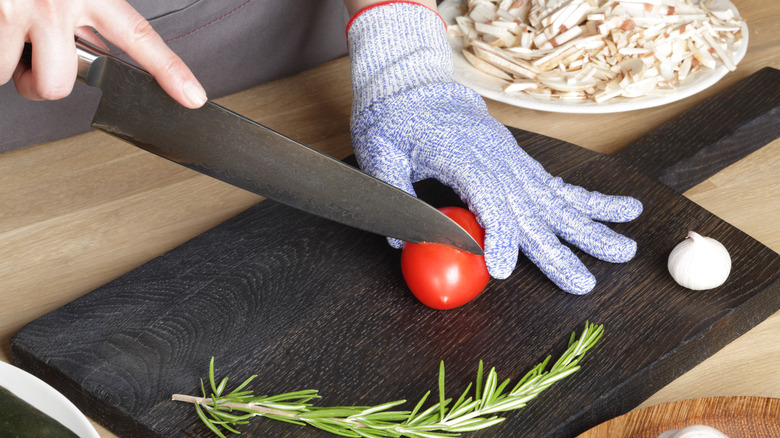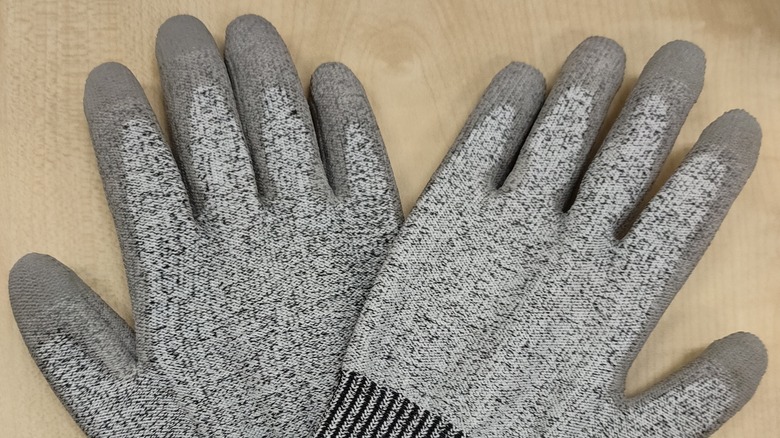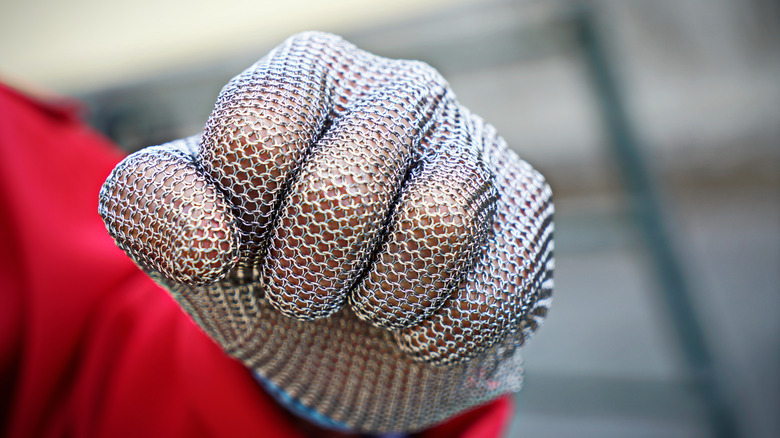Will Cut-Resistant Gloves Actually Save You In The Kitchen?
Cut-resistant gloves sound like they could be a game-changer in the kitchen, but how well do they actually protect you? It turns out — pretty well! Now, the name can be misleading; they're not actually cut-proof. But if you invest in high-quality cut-resistant gloves, you could turn a potential emergency room nightmare into an unhappy, Band-Aid-treatable nick. Accidental kitchen cuts do happen, but cut-resistant gloves can greatly reduce their severity if you're wearing the appropriate kind.
Of course, it's important to have sufficient knife skills in the kitchen and to always follow any and all food-handling safety protocols to ensure you're keeping yourself and others from being injured. Still, if you're handling extra-unwieldy food items such as large fruits — like melons and squash that have a particularly tough rind — you could benefit from using cut-resistant gloves. Cut-resistant gloves are good for all kinds of food preparation and kitchen maintenance, but it's important to note that not all gloves are created equally. Some gloves are better suited for some jobs than others, and it can be tricky to weigh the pros against the cons when choosing a pair.
How cut-resistant gloves work
An obvious advantage of cut-resistant gloves is that they're designed to help prevent or reduce the severity of injury when using a knife. One of the most common types of cuts you can suffer in the kitchen is from what is known as "downward force" from the blade. Imagine you're chopping carrots and you lose your grip at the nub-end of the veg, but you've cut straight down with a decent amount of strength — that's downward force. If you're wearing cut-resistant gloves, you might emerge unharmed. Most cut-resistant gloves are constructed with reinforced fibers that are stretch-resistant and absorb force, making it harder for a blade to penetrate. But this isn't to say they're foolproof: If enough force is applied, a blade can still break through and injure you.
While the extra layer of protection is difficult to argue with, there are a few drawbacks to using gloves of any kind in the kitchen. Gloves can be sanitary and help reduce bacteria and contamination, but they can also harbor all kinds of germs and pose a real risk to food safety if handled incorrectly — so regularly washing your cut-resistant gloves is important. And don't worry about deteriorating the quality of their resistance; according to PPE manufacturer Tilsatec, washing can actually improve the fabric's density. When gloves are new, they have a bit more give — and that can work against you when it comes to cut prevention.
Weighing protective layers against dexterity
Why not simply choose a thicker, denser glove that can stand up to more knife force in the kitchen? They do exist: The fibers of cut-resistant gloves are made from a number of fiber-metal blends and have different gauge yarns. These blends make the gloves thicker or thinner, depending on the weight of the gauge — think 21st-century chainmail, but made for cutting onions instead of combat. Gloves with more metal can protect against more force, while gloves with less metal are thinner; however, they also allow for better handling and user mobility, which can be just as important as coverage when it comes to blade safety. Remember, having less control over your hands while handling sharp objects could result in a situation of equal or higher risk than wearing no gloves at all.
That can make a palm coating on the gloves a slight disadvantage. According to PPE manufacturer Superior Glove, a palm coating is mostly there for the preservation of the glove fibers and somewhat enhanced grip; it really doesn't offer any additional protection and can often make the gloves stiffer. Dexterity is key, so gauge your need for free movement when choosing a pair of gloves that's right for you. At the end of the day, cut-resistant gloves can be a boon to home cooks, but they're simply resistant, not cut-proof — so make sure to practice proper knife safety regardless of whether you're wearing them.


